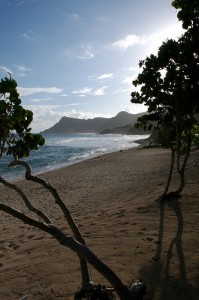 For years while working on the trading floor, I’d hear fellow coworkers rave about their fabulous holiday with their spouse in St. Barth’s. At the time, I was single. My best friend Premila and I had a blast traveling the world together, often visiting many “romantic” destinations – Santorini, wine tasting in Tuscany… you get the picture. However, I told Prem that I wanted to save this particular romantic destination – St. Barth’s – for my future, unknown husband, whom I lovingly referred to at the time as “Mr. Man.” Years later, when I finally met “Mr. Man,” we did make it to St. Barth’s. We both fell in love with it. We even got married there. Prem and I did eventually visit St. Barth’s together, where she did a bang up job of officiating our wedding ceremony.
For years while working on the trading floor, I’d hear fellow coworkers rave about their fabulous holiday with their spouse in St. Barth’s. At the time, I was single. My best friend Premila and I had a blast traveling the world together, often visiting many “romantic” destinations – Santorini, wine tasting in Tuscany… you get the picture. However, I told Prem that I wanted to save this particular romantic destination – St. Barth’s – for my future, unknown husband, whom I lovingly referred to at the time as “Mr. Man.” Years later, when I finally met “Mr. Man,” we did make it to St. Barth’s. We both fell in love with it. We even got married there. Prem and I did eventually visit St. Barth’s together, where she did a bang up job of officiating our wedding ceremony.
I can’t get enough of this gorgeous place. From New York, we can take an early morning flight and be on the beach with cocktail in hand by early afternoon. It’s not the cheapest place on earth, but it’s such an amazing experience… the island, the food, the people. My husband is French, so it offers a bit for both of us. The combination of these elements makes St. Barth’s one of our annual trips (um, we throw Vegas in there too). I am frequently asked to list our faves. Et voila:
Dining
Moderate
L’Esprit Saline
Anse de Grande Saline
+590 590 52 46 10
This laid back, Vietnamese inspired restaurant kept everything fresh and simple. We loved it so much that we visited it twice on our most recent trip. We started with freshly prepared humus. I could really taste the tahini. Next, we had tempura-fried shrimp over arugula salad with thick balsamic vinegar and an Asian dressing. I had the shrimp on skewers with amazing fresh herbs and garlic over a sweet potato purée and snap peas. My husband opted for the Daurade, which was perfectly cooked and served with just enough butter and lemon. It was also accompanied by the potato purée and snap peas. We were told to save room for the molten chocolate cake with passion fruit and crème. L’Esprit seems to be a local favorite.
Fancy
 Le Sereno
Le Sereno
Grand Cul de Sac
+590 590 298 300
Full disclosure: We had our wedding here. Maybe I am partial, maybe I am not. What I do know is that they made our entire experience magical, from the food, to the organizing, to the details. The staff was on top of its game, but I especially have to thank the restaurant manager, Jean-Pierre Giroux, who is a class act unto himself.
Hotel or dining… Le Sereno is our go-to in St. Barth’s. I’d describe this restaurant as casual fancy. The location and staff are amazing. The chef is very talented. The restaurant manager runs a tight ship and is very attentive to detail. Some of our absolute favorite dishes here are the Pata Negra, salads (especially the ones with seafood), fish and pasta. If you read my articles regularly, you are already aware of my obsession with Pata Negra. Their fish is super fresh and the selection depends upon the fisherman’s luck from that day. If you want to keep it simple and control costs, opt for lunch or a snack instead of dinner, but go. Their mixology can’t be beat. Le Sereno has great options for cocktails with and without alcohol. There were a few expecting couples at the restaurant and hotel this time around who were on holiday and enjoying a little R&R prior to baby time. For those who do drink, as an experiment, I dare you to ask for a cocktail without alcohol. See what you get at most restaurants – possibly orange juice, grapefruit juice or exotic cranberry and soda water. Really people? A little effort here… Le Sereno has all bases covered. Even if you don’t go for a meal, do have a cocktail here as the sun goes down over the cove, and maybe a snack like Pata Negra (is my brainwashing working?). Our favorite cocktail is a Mojito with strawberries, which we nicknamed Le Sereno Mojito. I included the recipe below.
Case de L’Isle
+590 590 27 58 68
This French gastronomic restaurant is situated at the Isle de France hotel on Flamands Bay. We went for dinner, but it would be a very tasty option for lunch as well. You can hear the waves crashing as you dine, creating a very romantic atmosphere. My sea bass was perfectly crispy on the outside and flaky in the inside. They served it over their “famous” cooked down fennel. It was superb. The lobster bisque was also a hit, but be prepared, as this dish, no matter how you slice it, is rich. They also serve a risotto of the day, which is amazing. We indulged, but we were certain to hit the gym the next day.
For those who enjoy cigars, they also have a cigar menu. They just ask that if you partake, that you comply with their request to smoke elsewhere to prevent “influencing” everyone else’s dining experience. Unfortunately, this time around, we had an arrogant and self-important man nearby who possibly couldn’t read and chose to smoke right next to everyone for a while. The staff was so polite and initially didn’t confront him because they figured that he’d get it. He didn’t. Eventually, the staff had to request that he move. Who are these people? The food was great. The atmosphere (sans the cigar guy) was very romantic. We’d definitely revisit.
Super Fancy
Le Gaiac – Hotel Le Toiny
Anse de Toiny
+590 590 297 747
This is for your over the top, blow the bank, super fancy meal. Be prepared to make a little dent in your credit card, but it is a special dining experience. The veal chop is always a treat. They bake it in a crust of sea salt. Their seafood dishes are fail-proof. Their wine list solid. Listen for their specials too. One time, we had their pasta, which was prepared tableside in a giant wheel of Parmesan cheese. I am certain that it was fat free. They are big on the tableside preparation here, but it’s kind of festive and changes things up a bit.
Don’t Really Understand the Hype, but Maybe for Someone Else?
Eden Rock
 +590 590 297 999
+590 590 297 999
The hotel made Conde Naste’s 2010 Gold List and it is a Relais et Chateau. A lot of people swoon over Eden Rock. I admit that I don’t get it, but I am including this restaurant because perhaps it’s for someone else? It is very “St. Tropez” and that’s just not my gig. I also found it to be very pricey. That being said, again, many rave about it and they do have fantastic views. The restaurant is perched out on a rock, which jets out a bit from the beach. For those in my camp, it is an interesting place to have cocktails and people watch during the day. At night, they shine a giant light on the ocean that says “Eden Rock,” so depending on your shtick….
Activities
- Gouverneur Beach – You must go. It’s stunning, rustic and a beautiful experience. Just be with the waves and ride them in.
- Scuba diving – Sharks, tons of tropical fish… just do it.
Recipe: For Those Who Can’t Make it to St. Barth’s, But Want a Little Tasty Treat at Home: Le Sereno Mojito
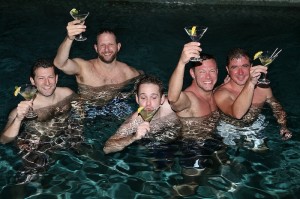 My sister-in-law and her boyfriend were smart enough to ask for the recipe before we left. (Merci bien Marion et Lio.) This particular cocktail always makes our family smile. We hope it has the same effect on you. Note: The glasses featured in this photo aren’t the ones we use for Le Sereno Mojito. We opt for a tall glass, but I can assure you that those featured in this photo from our après mariage soirée did have one or TWO Sereno Mojitos.
My sister-in-law and her boyfriend were smart enough to ask for the recipe before we left. (Merci bien Marion et Lio.) This particular cocktail always makes our family smile. We hope it has the same effect on you. Note: The glasses featured in this photo aren’t the ones we use for Le Sereno Mojito. We opt for a tall glass, but I can assure you that those featured in this photo from our après mariage soirée did have one or TWO Sereno Mojitos.
In a cocktail glass, put ice and strawberries chopped up in little pieces. Add some brown sugar and a few mint leaves. Mix 1/5 vodka, 3/5 blood orange juice and 1/5 sparkling water. Close your eyes and think of the beach!
Et pour mes amis et famille français:
Dans un verre à cocktail, mettre de la glace pilée et des fraises coupées en petit morceaux. Piler soigneusement tout ça ensemble. Rajouter de la cassonade et quelques feuilles de menthe. Mélanger, rajouter de la vodka (1/5), du jus d’orange sanguine (3/5), et du Perrier (1/5). Fermer les yeux et se croire sur la plage!

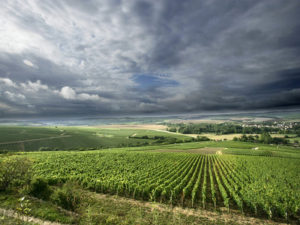
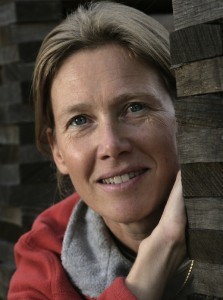
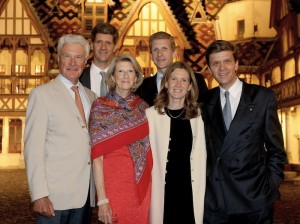

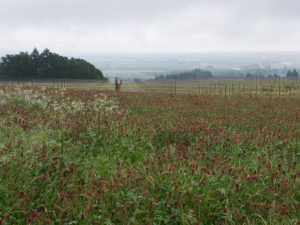
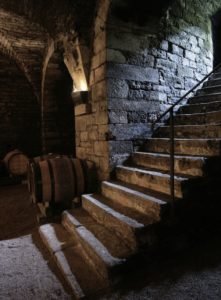
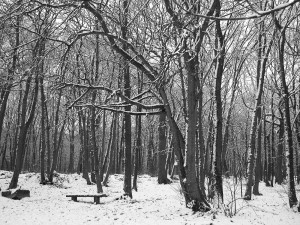



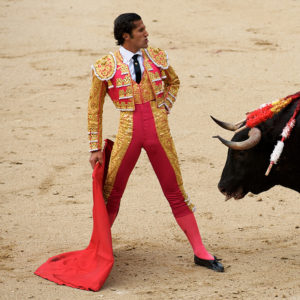
 Plaza de San Miquel, Los Austrias
Plaza de San Miquel, Los Austrias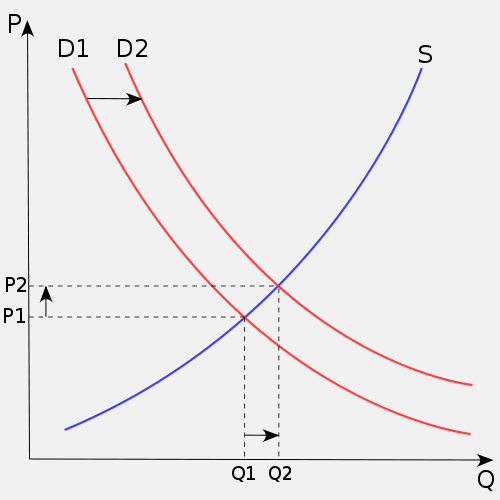 Guess what? We’re not the only ones who think Burgundies are fabulous. To quote Michael Jackson, “you are not alone.”
Guess what? We’re not the only ones who think Burgundies are fabulous. To quote Michael Jackson, “you are not alone.”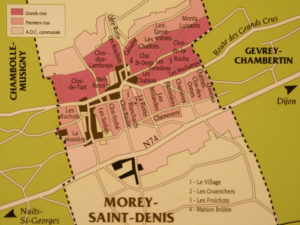 Morey-Saint-Denis
Morey-Saint-Denis

